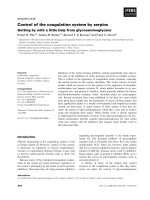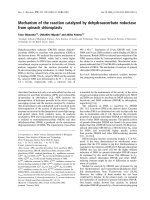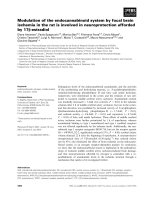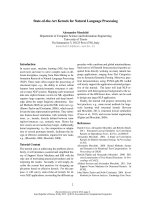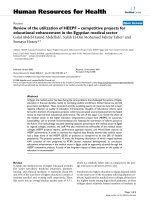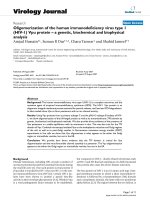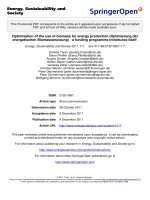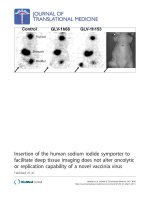Báo cáo sinh học: " Transduction of the rat brain by Bovine Herpesvirus 4" pdf
Bạn đang xem bản rút gọn của tài liệu. Xem và tải ngay bản đầy đủ của tài liệu tại đây (1.74 MB, 4 trang )
BioMed Central
Page 1 of 4
(page number not for citation purposes)
Genetic Vaccines and Therapy
Open Access
Short paper
Transduction of the rat brain by Bovine Herpesvirus 4
Marco Redaelli
1,2
, Andrea Cavaggioni
1
, Carla Mucignat-Caretta
1,2
,
Sandro Cavirani
3
, Antonio Caretta
4
and Gaetano Donofrio*
3
Address:
1
Department of Human Anatomy and Physiology, University of Padova, 35131 Padova, Italy,
2
Department of Neuroscience, University
of Padova, 35131 Padova, Italy,
3
Department of Animal Health, University of Parma, 43100 Parma, Italy and
4
Department of Pharmaceutical
Sciences, University of Parma, 43100 Parma, Italy
Email: Marco Redaelli - ; Andrea Cavaggioni - ; Carla Mucignat-
Caretta - ; Sandro Cavirani - ; Antonio Caretta - ;
Gaetano Donofrio* -
* Corresponding author
Abstract
Bovine herpesvirus 4 (BoHV-4) is a gamma-herpesvirus with no clear disease association. A
recombinant BoHV-4 (BoHV-4EGFPΔTK) expressing Green Fluorescent Protein (EGFP), was
successfully used to infect F98 rat glioma cells. BoHV-4EGFPΔTK was injected into the lateral
ventricle of the rat brain. Histology and immunohistochemistry showed that ependymal and rostral
migratory stream cells were transduced while neurons were not. Clinical scores, evaluated for 90
days, indicated that the virus was non neuropathogenic, suggesting this virus is a suitable vector for
brain tumor gene therapy.
Text
Gene delivery and targeting is a major issue in the treat-
ment of severe brain tumors. The cancer treatment medi-
ated or coadiuvated by genetically modified oncolytic
viruses is an interesting opportunity in clinical oncology.
Bovine herpesvirus 4 (BoHV-4) is a gamma-herpesvirus
with no clear disease association [1], suggesting it as a
suitable vector for gene therapy. BoHV-4 has been isolated
from different tissues and has been show to establish a
persistent infection in its natural host, the cattle, and in
the experimental animal, the rabbit [2,3]. In the natural
and experimental host some evidence indicates that the
monocyte/macrophage lineage is a site of persistent infec-
tion [4,5]. Interestingly, unlike other gamma-herpes
viruses like Epstein-Barr Virus [6] and Herpes Virus
Saimiri [7], BoHV-4 is non oncogenic. Hence, BoHV-4
could be employed as a possible therapeutic candidate as
attenuation of genes to render it non-pathogenic is not
required. However, BoHV-4 does replicate and cause a
cytopathic effect in a number of immortalized cell lines
and primary cell cultures [8,9].
We have previously demonstrated that BoHV-4 does not
replicate in the mouse brain and that infection was
restricted to ependymal and rostral migratory stream
(RMS) regions after viral injection in the lateral ventricle
of the mouse brain [10]. The aim of this work was to eval-
uate the suitability of BoHV-4 as a vector for glioma gene
therapy. The virus was first assessed in vitro, using the rat
glioma F98 cell line (ATCC, USA) and then in vivo by
injecting the virus into the brain of rats.
The infection and transduction of rat glioma cells in vitro
was explored, employing the rat glioma F98 cell line,
which were maintained in growth medium (90% DMEM,
Published: 12 February 2008
Genetic Vaccines and Therapy 2008, 6:6 doi:10.1186/1479-0556-6-6
Received: 30 October 2007
Accepted: 12 February 2008
This article is available from: />© 2008 Redaelli et al; licensee BioMed Central Ltd.
This is an Open Access article distributed under the terms of the Creative Commons Attribution License ( />),
which permits unrestricted use, distribution, and reproduction in any medium, provided the original work is properly cited.
Genetic Vaccines and Therapy 2008, 6:6 />Page 2 of 4
(page number not for citation purposes)
10% FBS, 100 IU/ml penicillin, 10 μg/ml streptomycin),
at 37°C in a humidified incubator with 95% air and 5%
CO
2
. F98 cells were cultured till 80–90% confluent (4–6
days) and exposed to a multiplicity of infection (m.o.i.) of
5 with recombinant BoHV-4 (BoHV-4EGFPΔTK)
obtained by the insertion of an EGFP gene into the TK
locus of the BoHV-4 genome [8], allowing rapid monitor-
ing of the cell infection through EGFP expression. Cells
were monitored for 9 days with an epiflorescence micro-
scope and the establishment of infection was detectable as
early as 48 h post-infection (Fig 1a and 1b). Cells were
successfully transduced with an efficiency ranging from
~15% after 3 days to ~30% after 9 days post infection,
despite the medium being changed every 3 days. Cyto-
pathic effects (CPE) were observed following infection.
In vitro, BoHV-4 is able to replicate in primary cell culture
or cell lines from a broad spectrum of host species. The
infection in some permissive cells leads to viral progeny
and CPE; in other cells, although CPE takes place, no viral
progeny is produced; whereas in some non permissive
cells BoHV-4 infection is persistent with no effect on cell
survival [11]. The nature of cell death induced by BoHV-4
is highly controversial. For some cell types, it is mediated
by apoptosis [12-14], but in other cells BoHV-4 infection
protects against TNF-alpha induced apoptosis [12]. Since
BoHV-4 induced CPE in F98 cells, the nature of cell death
was investigated. F98 cells were infected with 5 m.o.i. of
BoHV-4 and cell death was examined by Wright's nuclear
staining with propidium iodide and by internucleosomal
DNA fragmentation. Both approaches showed that BoHV-
4-induced CPE was not mediated by apoptosis (data not
shown).
With the assumption that BoHV-4 had a replicating com-
petent behavior in F98 cells that led to CPE, the outcome
of infection following BoHV-4 inoculation into the adult
rat brains was investigated to rule out a possible neu-
ropathogenic effect. All animals were cared for and used
in accordance with the Italian laws for animal experimen-
tation. Wistar rats were maintained at 24°C with a con-
trolled light cycle (12 h light, starting from 06:00 a.m.)
and with food and water ad libitum. For intracerebral
virus injection, 21 four-month-old male Wistar rats (3 rats
per group and per time point) were pre-anaesthetized
with isoflurane and then anaesthetized with ketamine (20
mg/kg body weight) and xylazine (75 mg/kg body
weight). Rats were inoculated with a high dose (12 × 10
6
Tissue Infectious Dose 50, TCID50, corresponding to 12
μl) of BoHV-4EGFPΔTK into the left lateral ventricle of the
brain, by a Hamilton syringe (0.5 μl/min) using the stereo
tactic coordinates from bregma (AP +1, ML -1.5, DV -3.7
mm). Throughout the experiment, each animal was mon-
itored daily to determine the degree of clinical impair-
ment until 90 days post inoculation (p.i.), using a visual
assessment scale [10]. Interestingly, all rats inoculated
with the virus showed no clinical signs. The transduction
capability of BoHV-4EGFPΔTK was analyzed through
EGFP expression in serial rat brain section, at 4, 6, 14, 27,
45, 60, and 90 days p.i Anaesthetized rats were perfused
with PBS for 15 min and then with 4% formalin in PBS for
30 min. Brains were carefully removed, post-fixed for 2
hours at 4°C (with 4% formalin in PBS), equilibrated for
24 h in 30% sucrose/PBS at 4°C and frozen at -80°C until
cryostat sectioning. Brain sections were stored at -20°C.
After thawing, brains sections were observed with an epif-
luorescence microscope. EGFP labelled cells were mapped
using the Paxinos and Watson atlas [15] and EGFP expres-
sion was observed as early as 4 days p.i., till 60 days p.i.
(see representative image, Fig. 2) and mainly localized in
two areas: in the proximity of the lateral ventricle border
and in the Rostral Migratory Stream (RMS). The percent-
age of transduction was ~10% up to day 60 p.i., however
at day 90 p.i. the EGFP signal disappeared (percentage of
transduction was calculated on the basis of 10 slices for
Rat glioma F98 cells culture infected with BoHV-4EGFPΔTKFigure 1
Rat glioma F98 cells culture infected with BoHV-
4EGFPΔTK. (a), epifluorescence; (b) Representative
image of BoHV-4EGFPΔTK infected F98 cells
expressing EGFP.
Genetic Vaccines and Therapy 2008, 6:6 />Page 3 of 4
(page number not for citation purposes)
each brain and 5 fields of view for each slice. The ratio
between EGFP positive cells on DAPI counterstained blue
cells was made. Data were expressed as ± SEM. Statistical
significance of differences was determined by the
unpaired student's t test. Differences at P < 0.05 were con-
sidered to be statistically significant).
Because the EGFP signal was localised to the area of inoc-
ulum and did not invade the parenchyma and cause clin-
ical signs, this indicated that BoHV-4EGFPΔTK infection
was unpermissive in the rat brain, as compared to the rep-
lication-competent behaviour of BoHV-4EGFPΔTK
observed in glioma cells in vitro. To characterize further
EGFP expressing cells in the transduced rat brains, Neuro-
trace stain (Molecular Probes) was used according to the
manufacturer's protocol. No co-localization with EGFP
signal was shown, indicating that BoHV-4EGFPΔTK did
not infect neurons (Fig 3a, 3b, 3c). For immunohisto-
chemistry, sections were rinsed with PBS, permeabilized
with 1% Triton-X 100 in PBS for 10 min, blocked with
bovine serum albumin (0.4% in PBS), incubated over-
night with the astrocyte marker anti-GFAP antibody
(Sigma, diluted 1:250 in PBS) in a humid chamber. After
rinsing the sections, sections were incubated with second-
ary antibody (antimouse Alexa 568, Molecular Probes,
Eugene, OR, 1:250 in PBS) for 3 hours at 4°C in humid
chamber. Some of the EGFP expressing cells in the RMS
area were labelled with the anti-GFAP signal and were
identified as astrocyte cells (Fig 4a, 4b, 4c).
The most interesting observation made during this study,
was the ability of BoHV-4EGFPΔTK to replicate in highly
replicating glioma cells but not in post mitotic brain cells.
This observation could be explained by a proteomic
switch occurring in the intracellular microenvironment of
tumor cells capable of activating the full replication cycle
of BoHV-4EGFPΔTK.
The absence of pathogenicity in the rat brain and the abil-
ity to establish a permissive infection in cultures of glioma
cells, make BoHV-4 an ideal candidate as a gene delivery
or oncolytic vector for gliomas in the nervous system.
Rat RMS 96 hours post BoHV-4EGFPΔTK injection, EGFP expression (a), NeuroTrace™ staining in red (b), merge (c), 40× oil confocalFigure 3
Rat RMS 96 hours post BoHV-4EGFPΔTK injection,
EGFP expression (a), NeuroTrace™ staining in red
(b), merge (c), 40× oil confocal.
Rat RMS area 6 days post BoHV-4EGFPΔTK injectionFigure 2
Rat RMS area 6 days post BoHV-4EGFPΔTK injec-
tion. EGFP expression, 20× epifluorescence.
Rat RMS 6 days post BoHV-4EGFPΔTK injection, EGFP expression (a), GFAP immunostainig (b), co-localization (c), 20× epifluorescenceFigure 4
Rat RMS 6 days post BoHV-4EGFPΔTK injection,
EGFP expression (a), GFAP immunostainig (b), co-
localization (c), 20× epifluorescence.
Publish with BioMed Central and every
scientist can read your work free of charge
"BioMed Central will be the most significant development for
disseminating the results of biomedical research in our lifetime."
Sir Paul Nurse, Cancer Research UK
Your research papers will be:
available free of charge to the entire biomedical community
peer reviewed and published immediately upon acceptance
cited in PubMed and archived on PubMed Central
yours — you keep the copyright
Submit your manuscript here:
/>BioMedcentral
Genetic Vaccines and Therapy 2008, 6:6 />Page 4 of 4
(page number not for citation purposes)
Authors' contributions
Redaelli M., carried out the in vivo and in vitro experi-
ments and helped to draft the manuscript. Cavaggioni A.,
participated in the design of the study and helped to draft
the manuscript. Mucignat-Caretta C., participated in the
design of the study, analyzed the frozen tissue section and
helped to draft the manuscript. Caretta A., participated in
the design of the study and prepared the frozen tissue sec-
tion. Donofrio G., designed the study, prepared the viral
vector and helped to draft the manuscript. All authors
read and approved the final manuscript.
Acknowledgements
We would like to thank Dr. Shan Herath (university of London) for English
editing of the manuscript and Italian Minister of Science (Prin 2005) and
Fondazione CARIPARMA for financial support.
References
1. Bartha A, Fadol AM, Liebermann H, Ludwig H, Mohanty SB, Osorio
FA, Reed DE, Storz J, Straub OC, Van der Maaten MJ, Wellermans G:
Problems concerning the taxonomy of the "Movar-Type"
bovine herpesvirus. Intervirology 1987, 28:1-7.
2. Dubuisson J, Thiry E, Bublot M, Thomas I, van Bressem MF, Coignoul
F, Pastoret PP: Experimental infection of bulls with a genital
isolate of bovine herpesvirus-4 and reactivation of latent
virus with dexamethasone. Vet Microbiol 1989, 21:97-114.
3. Osorio FA, Reed DE, Rock DL: Experimental infection of rabbits
with bovine herpesvirus-4: acute and persistent infection. Vet
Microbiol 1982, 7:503-513.
4. Egyed L, Bartha A: PCR studies on the potential sites for
latency of BHV-4 in calves. Vet Res Commun 1998, 22:209-216.
5. Osorio FA, Rock DL, Reed DE: Studies on the pathogenesis of a
bovine cytomegalo-like virus in an experimental host. J Gen
Virol 1985, 66:1941-1951.
6. Nilsson K: The nature of lymphoid cell lines and their relation-
ship to the virus. In The Epstein-Barr Virus Edited by: Epstein MA,
BG. Berlin: Achong, Springer-Verlag; 1979:225-281.
7. Jung JU, Choi JK, Ensser A, Biesinger B: Herpesvirus saimiri as a
model for gammaherpesvirus oncogenesis. Semin Cancer Biol
1999, 9:231-239.
8. Donofrio G, Cavirani S, Taddei S, van Santen VL: Bovine herpesvi-
rus 4 as a gene delivery vector. J Virol Methods 2002, 10:49-61.
9. Peterson RB, Goyal SM: Propagation and quantitation of animal
herpesviruses in eight cell culture systems. Comp Immunol
Microb Infect Dis 1988, 11(2):93-98.
10. Donofrio G, Cavaggioni A, Bondi M, Cavirani S, Flammini CF, Mucig-
nat-Caretta C: Outcome of bovine herpesvirus 4 infection fol-
lowing direct viral injection in the lateral ventricle of the
mouse brain. Microbes Infect 2006, 8:898-904.
11. Donofrio G, Cavirani S, van Santen VL: Establishment of a cell line
persistently infected with bovine herpesvirus-4 by use of a
recombinant virus. J Gen Virol 2000, 81:1807-1814.
12. Gillet L, Minner F, Detry B, Farnir F, Willems L, Lambot M, Thiry E,
Pastoret PP, Schynts F, Vanderplasschen A: Investigation of the
susceptibility of human cell lines to bovine herpesvirus 4
infection: demonstration that human cells can support a
nonpermissive persistent infection which protects them
against tumor necrosis factor alpha-induced apoptosis. J Virol
2004, 78:2336-2347.
13. Pagnini U, Montagnaro S, Pacelli F, De Martino L, Florio S, Rocco D,
Iovane G, Pacilio M, Gabellini C, Marsili S, Giordano A: The involve-
ment of oxidative stress in bovine herpesvirus type 4-medi-
ated apoptosis. Front Biosci 2004, 9:2106-2114.
14. Sciortino MT, Perri D, Medici MA, Foti M, Orlandella BM, Mastino A:
The gamma-2-herpesvirus bovine herpesvirus 4 causes
apoptotic infection in permissive cell lines. Virology 2000,
277:27-39.
15. Paxinos G, Watson C: The rat brain sterotaxic coordinates. San
Diego: Academic Press; 1995.
